|
 Secure Site
Secure Site
|
 |
Archive for the 'yoga' Category
 Kid Yoga Lotus Pose Kick up your heels a little on your way to wisdom, freedom, and joy.
By Jenny Sauer-Klein
The great philosopher Plato said, “You can discover more about a person in an hour of play than in a year of conversation.” Playing is a powerful way to gain insight into yourself, too. Play brings you into contact with your natural state—anando hum(literally, “I am bliss”). It’s a state of harmonious connection with yourself, with your playmates, and with the greater whole. Its spirit is contagious and multiplies itself without effort, raising the vibration of everyone it touches.
Much like the state of deep meditation, true play is a mode of becoming fully present and available to the mystery and wonder of each unfolding moment. In that moment of complete immersion, you release the crystallized assumptions of your past experiences and enter a world of innocence and possibility.
Children can exist in this state for hours because they are not afraid to dream big, to pretend, to bring their fantasies to life; they believe that anything is possible. Falling, laughing, and getting back up to try again come naturally to them. But as we get older, patterns of self-doubt, fear, and mistrust of ourselves or others can interfere with our ability to play with happy abandon,to dare to take risks with an open heart.
Play is my life’s work. When I teach AcroYoga, I’m helping adults to feel like children again,to trust themselves and each other,and to rediscover that belief in infinite possibility. Most adults need a fine balance of structure and freedom in order to feel safe enough to play and take risks. When we fly in AcroYoga (imagine parent and child playing “airplane”), defined roles and rules help ensure everyone’s safety. The magic word is “down,” which means “time out—let’s come back down to earth.” The roles and rules satisfy the intellectual mind, creating space for the flier to experience the pure joy of being held in the air, probably for the first time since childhood. I often see initial fear and doubt turn into elation and empowerment, as people build the trust and confidence they need to spread their wings!
The ancient rishis and seers who gave birth to the practice we call yoga began from this place of freedom and benevolent curiosity, asking questions that would guide the evolution of human consciousness. All of our great systems of knowledge, from medicine to philosophy to the great spiritual traditions, originated from this inherent sense of wonder and openness. Throughout the ages,wisdom has come to those willing to experiment and discover the next leading edge. When you surrender to the spiritual practice of play, you are celebrating the existence of life itself. Are you willing to leave the known behind and ask what is possible now?
Jenny Sauer-Klein is the co-founder of AcroYoga. Find out more at acroyoga.org.
Make A Play Date
Four ideas to bring wonder into your life
Instead of thinking about negative “what ifs,” play the positive “What If” game. Ask yourself, “What if I get my dream job?” “What if I open deeply to love?” Let your dreams become reality by asking, “How could this get any better?” And live the answer!
Try a different style of yoga or a new physical practice, like dance or the martial arts, and become a beginner again. Forgive yourself if you fumble and enjoy the process of learning. Spend time with a child or an animal. Watch them play and discover the world again through their eyes.
Give yourself permission to make a new mistake. Do Tree Pose with your eyes closed and see how long you last. Laugh if you fall down.
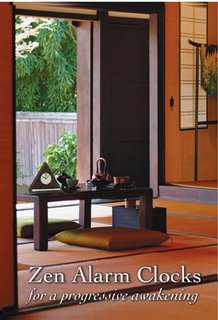 Zen Clocks and timers for yoga and meditation adapted from Yoga Journal.com August 2011
Now & Zen, Inc.
1638 Pearl St.
Boulder, CO 80302
(800) 779-6383
Posted in yoga, Yoga Timer, Yoga Timers by Now & Zen
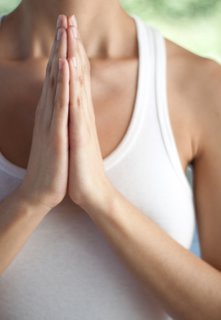 prayer is good medicine Two researchers find merit to the idea that spiritual influences can have a beneficial, physiologically measurable impact.
By Larry Sokoloff
Inspired by a visit to a hospital in India run by Sri Sathya Sai Baba and his followers, two Duke University researchers are investigating the effects prayer and other nonmedical practices can have on a patient’s recovery after angioplasty.
Cardiologist Mitchell W. Krucoff and nurse practitioner Suzanne Crater were amazed by the upbeat reaction of patients and staff at the Institute for Higher Medical Sciences in Putta Parthi following the daily visits of Sai Baba, whose followers worship him as an avatar, an incarnation of divinity.
In contrast to the lethargy and depression common in many hospitals, the euphoric atmosphere at the Institute was overwhelming, Krucoff says. Patients and staff were beaming throughout the researchers’ visit. “God came every day and made rounds and touched them,” Krucoff says. “That kind of atmosphere has got to have physiological impact.”
After their visit, the two researchers wanted to test the idea that spiritual influences could have a physiologically measurable impact. But how do you measure the religious influence that they had witnessed? As Krucoff says, “We couldn’t scatter Sai Baba clones or Mother Teresa clones all over the United States.”
Instead, Krucoff and Crater wondered what would happen if prayer and other forms of nonmedical treatment were offered to patients undergoing stressful heart procedures. Would patients who were prayed for or taught to relax benefit more than patients who were not? Their musings led them to begin the MANTRA study (Monitor and Actualization of Noetic TRAinings) at the Durham, North Carolina, Veterans Affairs Medical Center. Besides a group of patients who had prayers said for them, three other groups were exposed to touch, guided visualization, or stress relaxation. A fifth group served as a control group and did not receive any prayers or treatments.
The most unusual part of the study—and apparently the most effective—involved the healing use of prayer. The study found that angioplasty patients with acute coronary syndromes who were prayed for did 50 to 100 percent better (in terms of heart rate, blood pressure, and EKG results) than did patients in the control group. Patients who received guided imagery, touch, or stress relaxation assistance also benefited, showing a 30 to 50 percent trend toward improved outcomes.
Prayers were offered by seven different religious groups. Each group received the same data: the name of a male patient who was undergoing a catheter procedure, a stressful operation which involves threading a tube into the heart while the patient is awake. The prayers went out from Buddhist monasteries in Nepal and France, from Moravians in North Carolina, and from Carmelite nuns in Baltimore who prayed during evening vespers. In Jerusalem, prayers were inserted in the city’s Western Wall by a Jewish group. Fundamentalist Christians, Baptists, and Unitarians prayed as well.
The prayers proved effective even though the MANTRA patients didn’t know they were being prayed for, unlike the beaming patients in India who saw Sri Baba at their bedsides.
A larger trial of 1,500 patients is now under way at hospitals in North Carolina, San Diego, Washington, D.C., and Oklahoma City. The larger study will test whether the results can be repeated, and may influence doctors in the future to include spirituality in their prescriptions.
 Prayer timers and clocks with chimes Now & Zen, Inc.
1638 Pearl St.
Boulder, CO 80302
(800) 779-6383
adapted from Yoga Journal.com
Posted in yoga, Yoga Timers by Now & Zen
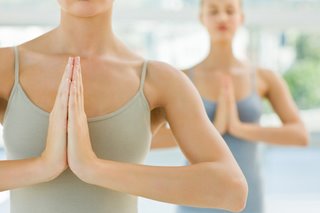 yoga fix Tension can be a pain in the neck. Master these gentle moves to create lasting ease.
By Barbara Benagh
By the time Tatiana Makoukhina came to my workshop last spring on easing tension in the neck, shoulders, and upper back, she’d been suffering from chronic pain for more than a decade. In the early ’90s, as a single mom newly arrived from Russia, Tatiana worried constantly about whether she could make a new life in America with her daughter. She put in long hours as a hotel cleaner—the only job she could find—and felt she could never relax, never stop working and planning. Her back and neck were constantly rigid with tension, she suffered severe migraines, and then she herniated a disk in her lower back lifting a heavy mattress.
Despite her persistent discomfort, Tatiana worked hard to manage her pain and improve her health. Athletic in her childhood—she had loved gymnastics, volleyball, and dancing—she began running and exercising again. Surgery for her disk injury helped with her lower back pain, and her migraines eased once she began practicing yoga regularly in 2002. Still, nothing seemed to banish the tightness, aches, and occasional stabbing pain in her shoulders and neck.
Tatiana certainly isn’t unique: We all live in a world filled with anxiety. We race through hectic days and fall into bed exhausted; we fret over our bills, our kids, our jobs and the state of the planet, too. It doesn’t help that many of us have lives skewed toward the sedentary, with too many hours spent hunkered down behind a computer or steering wheel. Our stress often winds up stored in clenched necks, shoulders, and backs-which eventually weakens our muscles, strains our joints, and limits our range of motion. The tension hangs heavy on our necks and shoulders, as unwelcome as a winter coat on a summer day.
It doesn’t have to be this way, of course. The shoulder girdle is designed so your arms, neck, and shoulders can move freely and easily. Even if you have a history of injuries or have suffered from chronic tension for years, the approach I’ve developed can help you learn to soften your neck and shoulder muscles and restore ease and freedom.
When I ran into Tatiana a few weeks after the workshop, she was thrilled with her progress. Not only had the workshop taken away her pain but, even better, she’d been able to stay pain-free by including 5 to 10 minutes of my exercises in her daily hour of yoga. Her back, shoulders, and neck were feeling more relaxed than she’d ever imagined possible.
Learn to Let Go
Passive relaxation exercises are the core of my program. Just about anyone can benefit from them, even those who’ve never done a single asana. These poses give you a taste of ease and comfort, a touchstone experience you can refer to again and again as you progress into more active exercises and challenging yoga poses.
Relaxing deeply is a sanctuary, yet few of us allow ourselves to enter it. It feels so good that you’d think it would come easily, but many of us are so accustomed to tension that we have to relearn the natural process of letting go.
The first step is simply lying down on your back on a firm, comfortable surface and letting yourself rest. Almost certainly, you’ll feel your muscles naturally releasing tension because they no longer have to work to hold you upright. You may notice you spontaneously let out a sigh of relief.
To relax more deeply, though, you have to consciously build on these natural responses. The secret to doing this is to focus on the movement of the breath in your body, using it to uncover and melt away tension.
Begin by tuning in to your breath. Pick up its rhythm, letting your muscles relax into and move with its gentle rise and fall. Throughout your practice, let this rhythm hold your attention. Feel how your breath creates an effortless expansion and contraction. Also notice any places in your body that seem tense or immobile or unresponsive to the ebb and flow of your breathing. To help them release, imagine saturating these tight, dull areas with the easy rhythm of your breath; if that doesn’t work, imagine your breath originating deep within your tense places.
Bringing your attention to your contracted spots will probably help them release. But if you’re like most people, you’ll also discover tension that’s stubbornly resistant to letting go. When that happens, remember to be patient and curious.
Chronically clenched muscles can feel tender, sore, rock hard, numb—or some combination of these sensations. Let your awareness drop deeper and deeper into each tight area, getting to know its specific character. With your breath, ask your muscles to slowly shift from tension to release, from density to expansion, from hard to soft.
Once you’ve experimented with this undoing process, apply it in some simple reclining positions like the Neck Blanket Stretch and the Arm-under-Back Stretch. These positions use body weight, position, and basic props to create gentle traction on classic neck and shoulder hot spots.
As you explore these passive exercises, don’t expect your tensions to melt away instantly. To undo your chronic patterns of holding, you have to learn to focus completely on letting go, and that takes time. Your undoing skills will mature with practice. The more often and more deeply you relax, the deeper your breath will penetrate, and the more subtle your awareness will become.
By starting the undoing process, you’ve begun a conversation with the residue your past has left behind in your body. Not only can the process lead you to much greater comfort, but it can also be profoundly contemplative and rich with insight. As you relax, you may discover emotions and memories that seem to have been locked within your tension. Years after my accident, I uncovered a surprising amount of anger at my sister for pushing me to go on that fateful date. The undoing process has led me to unexpected stores of positive feelings, too; when I began to practice again after a nearly fatal asthma attack, I found myself flooded with joy and gratitude.
As you continue to release chronic muscular holding, you’ll sense that contraction creates subtle vibrations of mental unease, and as these dissipate, you’ll discover that easing tension from your neck and shoulders calms your mind, too.
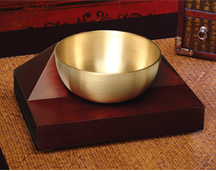 Yoga Timer with Tibetan Singing Bowl Use our unique “Zen Clock” which functions as a Yoga Timer. It features a long-resonating acoustic chime that brings your meditation or yoga session to a gradual close, preserving the environment of stillness while also acting as an effective time signal. Our Yoga Timer & Clock can be programmed to chime at the end of the meditation or yoga session or periodically throughout the session as a kind of sonic yantra. The beauty and functionality of the Zen Clock/Timer makes it a meditation tool that can actually help you “make time” for meditation in your life. Bring yourself back to balance.
 yoga accessories Now & Zen’s Yoga Timer Shop
1638 Pearl St.
Boulder, CO 80302
(800) 779-6383
Adapted from Yoga Journal.com by Barbara Benagh has taught yoga for 30 years. She lives in Boston and cofounded the Cambridge studio Yoga 301. Her website is www.yogastudio.org.
Posted in yoga, Yoga Timer, Yoga Timers by Now & Zen
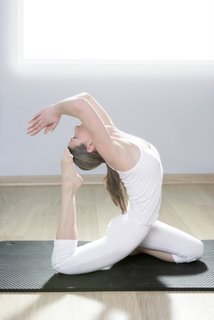 yoga body mind Release negative emotions and
improve your alignment by opening
the muscles around your hips.
By Diane Anderson, sequence by Stephanie Snyder
There are so many reasons to do hip-opening poses: Supple hips can ease back pain, give you a more agile gait, and even improve circulation in your legs. But there’s a more subtle benefit to hip openers, too: We hold stress and negative emotions—such as fear, guilt, and sadness—in our pelvis, says San Francisco vinyasa teacher Stephanie Snyder. For this reason alone, Snyder believes it’s particularly important to do poses that move prana (life force) through that area. “You know your junk drawer at home?” she asks. “The pelvis is like the body’s junk drawer. Whenever you don’t know what to do with a feeling or experience, you put it there.”
Snyder designed the following sequence to move your ball-and-socket hip joint through its full range of motion. When you do it regularly, you may see improvement in the rest of your practice, since the pelvis is the foundation of alignment in many poses. Here are some things to remember as you
do the sequence. Take your time with opening your hips, because hip ligaments are strong. “Don’t push yourself,” Snyder advises. “Be receptive to the breath moving into the pose.” If you have a knee injury, modify the seated poses (5 and 6) by straightening your bottom leg, and practice poses 7 and 9 on your back. At the same time, don’t avoid difficulty. People often dread hip openers because they are such a challenge. “Don’t look away from tight places,” Snyder says. “Be present without judgment. You can really make this a delicious practice.”
 Yoga tools and timers Now & Zen, Inc.
1638 Pearl St.
Boulder, CO 80302
(800) 779-6383
adapted from Yoga Journal.com
Posted in yoga, Yoga Timer, Yoga Timers by Now & Zen
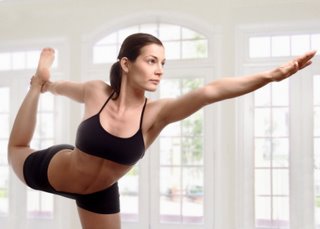 Winter Yoga For winter sports fans, yoga offers refined technique, better balance, and the freedom to fly.
When Hannah Dewey skis, she likes to go fast. “I tend to powerhouse it,” she says. “I muscle my way through.” As a longtime skier and a professional wildfire fighter, Hannah is strong enough to ski fast, even uphill. But after 22 years of skiing, she’s learned something surprising, a lesson that comes from her yoga practice: To get the most power, she has to slow down and focus her mind on the present moment. “If I go calmly step by step, concentrating on my form, I can actually go faster,” she says.
I met Hannah, along with more than 40 other skiers, at the eighth annual Women’s Ski and Yoga Retreat in the Methow Valley of northern Washington. I joined a group of athletes who do yoga for many reasons: to enhance their performance on skis, to ward off injury, and to experience the singular bliss that comes from a focused effort and a clear mind. “Yoga and skiing go together for me,” says Mary Ellen Stone, another retreat regular. “They’re both ways of putting away all the clutter in our lives and focusing physically, emotionally, and technically on something that’s not easy to do. But when it all comes together, it’s one of the best feelings in the world.”
I’d come to have my own experience of the synergy of yoga and skiing, but because I hadn’t skied since
I was a kid, getting faster was not my primary goal. Still, the lessons I’d internalized in my years of yoga practice turned out to serve me well on the trails.
Let It Snow
The secluded Methow Valley is a Nordic skier’s paradise. A popular place for Olympic skiers to train,
the valley has 120 miles of cross-country trails—one of the longest systems of groomed trails anywhere
in North America—as well as access to many more miles of challenging backcountry ski routes in the 4 million acres of the surrounding Okanogan-Wenatchee National Forest.
The women meet at Sun Mountain Lodge, the mountaintop resort hosting the retreat, which
is organized by the nearby Winthrop Fitness center. Many of my fellow retreat participants have skied competitively. Some are experts at downhill skiing but have come to master cross-country. A few are snow-sport newbies like me.
At 7 o’clock the next morning, I warm up my resistant quadriceps in Melanie Whittaker’s yoga class. Melanie is a cross-country skier and the yoga director for Winthrop Fitness, and has been practicing yoga for more than 30 years. She teaches an Iyengar-inspired style and counts elite skiers and other athletes among her students. She explains that we’re preparing ourselves to move forward with agility and speed while balancing on a slippery and constantly changing surface of snow and ice. For the next 90 minutes, she leads us through a series of strong
poses like Ardha Chandrasana (Half Moon Pose) and Virabhadrasana (Warrior Pose) I, II, and III, which call for strength, balance, and confidence—the same qualities we’ll need
to draw on once we strap on our skis.
Moving with any sort of grace on a slippery surface is inherently challenging, she tells us,
as we do Utkatasana (Chair Pose), and to keep our balance we’ll need a strong, compact form and a low center of gravity. She also reminds
us that to be successful at skiing, as with yoga, we have to learn to trust our bodies. When we do Handstand, she reminds us that it is trust that allows us to bring our hips over our heads, and our legs into the air. I’ll have occasion to remember her words later in the day.
Free Fall
After class I make my way, skis in hand, to a flat, groomed field for my beginner’s lesson.
A misty fog floats across the hills, just above the treetops, and occasional watery sunshine glints from behind the clouds.
The two most common kinds of cross country skis—classic and skate—have corresponding, but different, techniques. To move forward on classic skis, you keep your feet
parallel and execute a series of gliding lunges. With each step, you shift your center of gravity forward, bringing your body weight fully over the ball of the front foot, almost past the point where you feel you’re going to fall, while pushing the ground away with your back leg. To
balance and stay stable, says my instructor, you tuck into an Utkatasana-like form, bending your front knee and ankle, dropping your sitting bones, and firming your core.
When I ask some of the more experienced skiers, like Hannah, how their yoga practice supports their skiing, they emphasize core strength and balance. “In skiing, my form comes from my core,” says Hannah. “I concentrate on keeping my core really tight, and my legs just follow.” As the ski class gets under way, I see what she means. If I bend my ankles and knees and tip my weight forward, I glide. If I straighten up out of that slight tuck, I
wobble and, more often than not, fall.
“Bend your knees and ankles,” shouts my instructor. “Weight forward!” I bend my knees. I bend my ankles. I drop my sitting bones, finding the skier’s Utkatasana. I connect to the strength in my ankles, calves, and thighs and, with a slight adjustment, release my body weight forward. And there it is. I am gliding with a remarkable feeling of ease, making wide turns down the slope. I no longer feel that the skis are unruly clown shoes, tripping me up. They are seamless extensions of my legs, and they do my bidding.
That afternoon, we take off down a trail into the forest. I experience a delicious sense of well-being and freedom as I slide through the quiet forest and enjoy the afternoon sunlight gleaming through pine trees decked with garlands of sage-green moss. I’ll never look at Utkatasana the same way after today. Instead of feeling like a sweaty struggle for balance, it now feels like the pose of victory.
 Moss Garden Restore and Tend
That evening, the group meets for an apres-ski stretch, and I find Melanie for a quick consultation. All of that forward crouching has left me with a sore back. She has me try a variation of Sphinx Pose, in which I press my hands into the ground and work my upper arms toward each other to open up my upper back and chest. A supine twist relieves my lower back, and Supta Baddha Konasana (Reclining Bound Angle Pose) helps release the piriformis, a muscle deep in the buttocks that tends to tighten in skiing.
As to my other aches and pains—I’m feeling my shoulders, arms, core, inner thighs, outer thighs, calves, and ankles—she tells me I’m making the rookie mistake of unnecessarily gripping a lot of auxiliary muscles I don’t need to in the process of trying to engage the ones I do. “You’ll get more power and control when you learn to isolate the muscle groups you need,” she says. “You’ll also be a lot less sore and fatigued at the end of the day. Practicing the body awareness you learn in yoga will help you on the slopes.”
Being Balance
In the next morning’s yoga class, Melanie brings our attention to our feet. Being aware of our feet, she tells us, is a critical factor in balance. In Utthita Parsvakonasana (Extended Side Angle Pose), we practice putting even pressure through the entire foot, observing how the slightest shift to one side can unbalance us.
The skiing portion of the second day focuses on skate-style skiing. Skate skis are especially slippery. When you are moving across the snow’s slick surface, the slightest muscular effort creates motion, which presents a new kind of balancing challenge. To gain control of my movement, says my instructor, I have to master the art of “edging,” or delicately shifting weight to the inner edge of my foot to grip into the snow, which will allow me to push off into a glide.
As I slide around like a bumper car, I try to remember to spread my toes and keep my feet relaxed so that I can control how my weight shifts. Meanwhile, I’m fielding more instructions: Bend your knees, push off the back foot, shift weight to the front foot, bring one pole forward. Every time I try to do one thing the instructor tells us, I forget the others, tense up, and lose my balance. Finally she notices my difficulty and gives me yet another instruction: “You—just stop thinking!”
I pry my gaze away from my feet, look straight ahead in the direction I want to go, and thrust myself forward into a glide. I plunge forward, and this time I start to get the momentum, the slight swaying, the powerful back-leg strokes pushing me forward. I grin like a little kid, glancing at the teacher to make sure she sees me before my next slippery fall.
And then it occurs to me: Balance is not something you achieve and hold on to. It’s more ephemeral; it’s a string of temporary successes, held momentarily, lost, and then discovered again. Skiing gives you a fleeting experience of balance with each shift of weight and each glide. But it’s not permanent. When you lose it, you just have to have faith that you’ll come back to it.
Sweet Surrender
I feel I’ve been treated to a glimpse of the synergies of yoga and skiing. Hannah told me that her favorite yoga teacher reminds her to slow down and stay focused when she starts to rush through her Sun Salutations. Of all the benefits that her practice confers on her sport, she says, the most important one has come in the form of a mental shift: “Yoga has helped me slow down and concentrate on myself, and on having a good time out there.”
Mary Ellen echoes this sentiment: “When you’re out there and you see the snow sparkling on the trees and hear the ravens calling, you think, ‘I’m so lucky, so extraordinarily lucky, to be doing this.’ It’s a deep feeling, being there, right in that moment. That feeling is hard to come by.”
After dinner on the last night of the retreat, I make for the hot tub. I set my chin on the cold rock ledge of the tub and count a handful of lights in the houses in the valley below. The rest of my view consists of the snow-blanketed Mount Gardner. The full moon shines through the spreading branches of a pine tree on the slope before me. A rumbling sound disturbs the quiet as the trail grooming machine starts up. To my ears, it’s a sweet sound, promising freshly groomed trails to glide down in the morning.
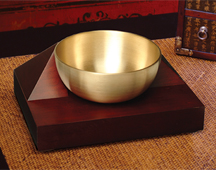 Timers for Yoga and Meditation with Tibetan Singing Bowl Use our unique “Zen Clock” which functions as a Yoga Timer. It features a long-resonating acoustic chime that brings your meditation or yoga session to a gradual close, preserving the environment of stillness while also acting as an effective time signal. Our Yoga Timer & Clock can be programmed to chime at the end of the meditation or yoga session or periodically throughout the session as a kind of sonic yantra. The beauty and functionality of the Zen Clock/Timer makes it a meditation tool that can actually help you “make time” for meditation in your life. Bring yourself back to balance.
 Meditation timers and chime clocks by Now & Zen, Inc. Now & Zen’s Yoga Timer Shop
1638 Pearl St.
Boulder, CO 80302
(800) 779-6383
Adapted from Yoga Journal.com, By Carmel Wroth, sequence by Melanie Whittaker.
Posted in Well-being, yoga, Yoga Timer, Yoga Timers by Now & Zen
 woman sun salutation yoga surya namaskar pose A kundalini awakening is when energy flows freely upward through the chakras and leads to an expanded state of consciousness. But is it safe?
According to Tantra, kundalini energy rests like a coiled serpent at the base of the spine. When this dormant energy flows freely upward through the seven chakras (energy centers) and leads to an expanded state of consciousness, it’s known as a kundalini awakening.
For some, the experience can be blissful and filled with feelings of love and a sense of the interconnectedness of all things. For others, it can feel more like a bad drug trip, or even a psychotic break, where practitioners go through altered sleep cycles, changes in identity, or depression. This discrepancy has led many Westerners to fear the coiled serpent resting in their spine, ready to strike.
Meditation teacher Sally Kempton had such an awakening in her late 20s, and while she acknowledges that the experience may be scary for those who are without an experienced teacher to guide them, she believes that awakenings are a gift from the universe. “In our tradition, we honor and respect kundalini,” she says. “Her energy is trying to awaken you, expand you, and put you in touch with your own deep energy, which is a fundamentally benign process.”
However, according to Kempton and Stuart Sovatsky, a psychotherapist specializing in spiritual work, kundalini awakenings are rare in Western students because hatha yoga is practiced in a less spontaneous way today. “People are trying to hold the poses in a certain way, as opposed to doing poses that release energy blocks specific to their body,” says Sovatsky.
Still, many teachers caution against attempts to induce an awakening through intense pranayama or other methods. Instead, it should occur spontaneously, when the body is ready. In Tantra: The Path of Ecstasy, yoga scholar Georg Feuerstein explains why: “If you don’t first open the central channels of the nervous system, raising the serpent power along the axial pathway is not only impossible but also very dangerous to attempt, for instead of entering the central channel (sushumna nadi) it is likely to force itself in to the ida or the pingala nadi, on either side of the central channel, causing immense havoc in the body and mind.”
Kundalini reminds us that consciousness is far vaster than most of us have ever imagined, which can seem overwhelming and disorienting. But Sovatsky says that people who have a psychotic break from an awakening usually come from a troubled family background, face high levels of stress, and don’t have enough emotional support. Still, both Sovatsky and Kempton recommend that anyone who is fearful in the midst of such an awakening should seek support from a therapist (such as a transpersonal psychologist) or a teacher who has gone through it herself.
adapted from Yoga Journal by By Nora Isaacs
 bamboo digital zen chime clock and yoga timer Now & Zen
1638 Pearl Street
Boulder, CO 80302
(800) 779-6383
Posted in yoga, Yoga Timer, Yoga Timers by Now & Zen
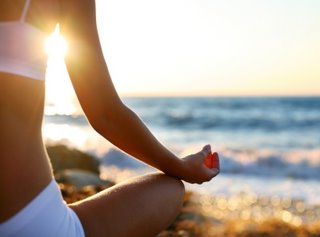 new light on yoga From loincloths to leotards, yoga has come a long way in 5,000 years. But is yoga as we know it really that old?
According to yoga scholars, even the yoga postures—the basic vocabulary of modern hatha yoga—have evolved and proliferated over time. In fact, only a handful of these now-familiar postures are described in the ancient texts. Patanjali’s second-century Yoga Sutra mentions no poses at all, other than the seated meditation posture. (The Sanskrit word “asana” literally means “seat.”) The fourteenth-century Hatha Yoga Pradipika—the ultimate classical hatha yoga manual—lists only 15 asanas (most of them variations of the cross-legged sitting position), for which it gives very sketchy instructions. The seventeenth-century Gheranda Samhita, another such manual, lists only 32. Conspicuously missing are the standing poses—Triangle, Warrior, etc.—and Sun Salutations that form the backbone of most contemporary systems.
Other venerable texts on hatha yoga eschew mention of asanas altogether, focusing instead on the subtle energy systems and chakras that the poses both reflect and influence. The modern emphases on precision of alignment, physical fitness, and therapeutic effects are purely twentieth-century innovations.
Rumors abound about lost, ancient texts that describe asanas in detail—the Ashtanga vinyasa system taught by Pattabhi Jois, for example, is allegedly based on a palm-leaf manuscript called the Yoga Korunta that Jois’s teacher, renowned yoga master T. Krishnamacharya, unearthed in a Calcutta library. But this manuscript has reportedly been eaten by ants; not even a copy of it exists. In fact, there’s no objective evidence that such a document ever existed. In all his voluminous writings on yoga—which contain extensive bibliographies of all the texts that have influenced his work—Krishnamacharya himself never mentions or quotes from it. Many of Krishnamacharya’s other teachings are based on an ancient text called the Yoga Rahasya—but this text too had been lost for centuries, until it was dictated to Krishnamacharya in a trance by the ghost of an ancestor who had been dead nearly a thousand years (a method of textual reclamation that will satisfy devotees, but not scholars).
In general, the textual documentation of hatha yoga is scanty and obscure, and delving into its murky history can be as frustrating as trying to snorkel in the mud-brown Ganges. Given the paucity of historical evidence, yoga students are left to take the antiquity of the asanas on faith, like fundamentalist Christians who believe that the Earth was created in seven days.
Not only is there no clear textual history, but there’s not even a clear teacher-student lineage that indicates systematized oral teachings handed down over generations. In Zen Buddhism, for example, students can chant a lineage of teachers stretching back for centuries, with each Zen master certified by the one preceding. No such unbroken chain of transmission exists in hatha yoga. For generations, hatha yoga was a rather obscure and occult corner of the yoga realm, viewed with disdain by mainstream practitioners, kept alive by a smattering of isolated ascetics in caves and Hindu maths (monasteries). It appears to have existed for centuries in seed form, lying dormant and surfacing again and again. In the twentieth century, it had almost died out in India. According to his biography, Krishnamacharya had to go all the way to Tibet to find a living master.
Given this lack of a clear historical lineage, how do we know what is “traditional” in hatha yoga? Where did our modern proliferation of poses and practices come from? Are they a twentieth-century invention? Or have they been handed down intact, from generation to generation, as part of an oral tradition that never made it into print?
The Mysore Palace
I found myself pondering these questions afresh recently after I came across a dense little book called The Yoga Tradition of the Mysore Palace (South Asia Books, 1996) by a Sanskrit scholar and hatha yoga student named Norman Sjoman. The book presents the first English translation of a yoga manual from the 1800s, which includes instructions for and illustrations of 122 postures—making it by far the most elaborate text on asanas in existence before the twentieth century. Entitled the Sritattvanidhi (pronounced “shree-tot-van-EE-dee”), the exquisitely illustrated manual was written by a prince in the Mysore Palace—a member of the same royal family that, a century later, would become the patron of yoga master Krishnamacharya and his world-famous students, B.K.S. Iyengar and Pattabhi Jois.
Sjoman first unearthed the Sritattvanidhi in the mid-1980s, as he was doing research in the private library of the Maharaja of Mysore. Dating from the early 1800s—the height of Mysore’s fame as a center of Indian arts, spirituality, and culture—the Sritattvanidhi was a compendium of classical information about a wide variety of subjects: deities, music, meditation, games, yoga, and natural history. It was compiled by Mummadi Krishnaraja Wodeyar, a renowned patron of education and the arts. Installed as a puppet Maharaja at age 5 by the British colonialists—and deposed by them for incompetence at the age of 36—Mummadi Krishnaraja Wodeyar devoted the rest of his life to studying and recording the classical wisdom of India.
At the time Sjoman discovered the manuscript, he had spent almost 20 years studying Sanskrit and Indian philosophy with pundits in Pune and Mysore. But his academic interests were balanced by years of study with hatha yoga masters Iyengar and Jois. As a yoga student, Sjoman was most intrigued by the section of the manuscript dealing with hatha yoga.
Sjoman knew that the Mysore Palace had long been a hub of yoga: Two of the most popular styles of yoga today—Iyengar and Ashtanga, whose precision and athleticism have profoundly influenced all contemporary yoga—have their roots there. From around 1930 until the late 1940s, the Maharaja of Mysore sponsored a yoga school in the palace, run by Krishnamacharya—and the young Iyengar and Jois were both among his students. The Maharaja funded Krishnamacharya and his yoga protégés to travel all over India giving yoga demonstrations, thereby encouraging an enormous popular revival of yoga. It was the Maharaja who paid for the now well-known 1930s film of Iyengar and Jois as teenagers demonstrating asanas—the earliest footage of yogis in action.
But as the Sritattvanidhi proves, the Mysore royal family’s enthusiasm for yoga went back at least a century earlier. The Sritattvanidhi includes instructions for 122 yoga poses, illustrated by stylized drawings of an Indian man in a topknot and loincloth. Most of these poses—which include handstands, backbends, foot-behind-the-head poses, Lotus variations, and rope exercises—are familiar to modern practitioners (although most of the Sanskrit names are different from the ones they are known by today). But they are far more elaborate than anything depicted in other pre-twentieth-century texts. The Sritattvanidhi, as Norman Sjoman instantly realized, was a missing link in the fragmented history of hatha yoga.
“This is the first textual evidence we have of a flourishing, well-developed asana system existing before the twentieth century—and in academic systems, textual evidence is what counts,” says Sjoman. “The manuscript points to tremendous yogic activity going on in that time period—and having that much textual documentation indicates a practice tradition at least 50 to 100 years older.”
Potpourri Lineage
Unlike earlier texts such as the Hatha Yoga Pradipika, the Sritattvanidhi doesn’t focus on the meditative or philosophical aspects of yoga; it doesn’t chart the nadis and chakras (the channels and hubs of subtle energy); it doesn’t teach pranayama (breathing exercises) or bandhas (energy locks). It’s the first known yogic text devoted entirely to asana practice—a prototypical “yoga workout.”
Hatha yoga students may find this text of interest simply as a novelty—a relic of a “yoga boom” of two centuries ago. (Future generations may pore with equal fascination over “Buns of Steel” yoga videos.) But buried in Sjoman’s somewhat abstruse commentary are some claims that shed new light on the history of hatha yoga—and, in the process, may call into question some cherished myths.
According to Sjoman, the Sritattvanidhi—or the broader yoga tradition it reflects—appears to be one of the sources for the yoga techniques taught by Krishnamacharya and passed on by Iyengar and Jois. In fact, the manuscript is listed as a resource in the bibliography of Krishnamacharya’s very first book on yoga, which was published—under the patronage of the Maharaja of Mysore—in the early 1930s. The Sritattvanidhi depicts dozens of poses that are depicted in Light on Yoga and practiced as part of the Ashtanga vinyasa series, but that don’t show up in any older texts.
But while the Sritattvanidhi extends the written history of the asanas a hundred years further back than has previously been documented, it does not support the popular myth of a monolithic, unchanging tradition of yoga poses. Rather, Sjoman says that the yoga section of the Sritattvanidhi is itself clearly a compilation, drawing on techniques from a wide range of disparate traditions. In addition to variations on poses from earlier yogic texts, it includes such things as the rope exercises used by Indian wrestlers and the danda push-ups developed at the vyayamasalas, the indigenous Indian gymnasiums. (In the twentieth century, these push-ups begin to show up as Chaturanga Dandasana, part of the Sun Salutation). In the Sritattvanidhi, these physical techniques are for the first time given yogic names and symbolism and incorporated into the body of yogic knowledge. The text reflects a practice tradition that is dynamic, creative, and syncretistic, rather than fixed and static. It does not limit itself to the asana systems described in more ancient texts: Instead, it builds on them.
In turn, says Sjoman, Krishnamacharya drew on the Sritattvanidhi tradition and blended it with a number of other sources, as Sjoman discovered by reading the various books by Krishnamacharya in the Maharaja’s library. Krishnamacharya’s first writings, which cited the Sritattvanidhi as a source, also featured vinyasa (sequences of poses synchronized with the breath) that Krishnamacharya said he had learned from a yoga teacher in Tibet. Over time, these vinyasa were gradually systematized further—Krishnamacharya’s later writings more closely resemble the vinyasa forms taught by Pattabhi Jois. “Therefore it seems logical to assume that the form we find in the series of asanas with Pattabhi Jois was developed during Krishnamacharya’s period of teaching,” writes Sjoman. “It was not an inherited format.” To dedicated Ashtanga practitioners, this claim borders on the heretical.
Along the way, claims Sjoman, Krishnamacharya also seems to have incorporated into the yogic canon specific techniques drawn from British gymnastics. In addition to being a patron of yoga, the Mysore royal family was a great patron of gymnastics. In the early 1900s, they hired a British gymnast to teach the young princes. When Krishnamacharya was brought to the palace to start a yoga school in the 1920s, his schoolroom was the former palace gymnastics hall, complete with wall ropes and other gymnastic aids, which Krishnamacharya used as yoga props. He was also given access to the Western gymnastics manual written by the Mysore Palace gymnasts. This manual—excerpted in Sjoman’s book—gives detailed instructions and illustrations for physical maneuvers that Sjoman argues quickly found their way into Krishnamacharya’s teachings, and passed on to Iyengar and Jois: for example, lolasana, the cross-legged jumpback that helps link together the vinyasa in the Ashtanga series, and Iyengar’s technique of walking the hands backward down a wall into a back arch.
Modern hatha yoga draws on British gymnastics? The yoga of Iyengar, Pattabhi Jois, and Krishnamacharya influenced by a potpourri that included Indian wrestlers? These are claims guaranteed to send a frisson of horror up the limber spine of any yoga fundamentalist. But according to Sjoman, his book is meant not to debunk yoga—but to pay tribute to it as a dynamic, growing, and ever-changing art.
Krishnamacharya’s genius, says Sjoman, is that he was able to meld these different practices in the fire of yoga philosophy. “All those things are Indianized, brought into the purview of the yoga system,” Sjoman says. After all, he points out, Patanjali’s only requirement for asana was that it be “steady and comfortable.” “This is a functional definition of asana,” he says. “What makes something yoga is not what is done, but how it is done.”
This realization, he says, can be liberating, paving the way for a greater appreciation of the role of individual intuition and creativity in the development of yoga. “Krishnamacharya was a great innovator and experimenter—that’s one of the things that gets missed in the tendency of Indians to make hagiographies of their teachers and to look for ancient lineages,” Sjoman says. “The experimental and creative abilities of both Krishnamacharya and Iyengar are very much overlooked.”
Of course, Sjoman’s scholarship is just one perspective on the Mysore Palace lineage. His research and conclusions may be flawed; the information he has uncovered is open to multiple interpretations.
But his theories point to a reality that you don’t have to probe very deeply into yoga history to confirm: There really is no one monolithic yoga tradition.
Rather, yoga is like a twisted old banyan tree, whose hundreds of branches each support a full load of texts, teachers, and traditions—often influencing one another, just as often contradicting one another. (“Be celibate,” admonishes one scripture. “Get enlightened through sex,” urges another.) Like snapshots of a dance, different texts freeze and capture different aspects of a living, breathing, changing tradition.
This realization can be unsettling at first. If there’s no one way to do things—well, then how do we know if we’re doing them right? Some of us may long for a definitive archaeological discovery: say, a terra-cotta figure of a yogi in Triangle Pose, circa 600 B.C., that will tell us once and for all how far apart the feet should be.
But on another level it’s liberating to realize that yoga, like life itself, is infinitely creative, expressing itself in a multitude of forms, re-creating itself to meet the needs of different times and cultures. It’s liberating to realize that the yoga poses are not fossils—they’re alive and bursting with possibility.
That’s not to say that honoring tradition is unimportant. It’s vital to honor the common goal that has united yogis for centuries: the quest for awakening. For thousands of years, yogis have sought to contact directly the luminous source of all being; and for hatha yogis in particular, the vehicle for touching the infinite spirit has been the finite human body. Every time we step on the mat, we can honor tradition by “yoking”—the original meaning of the word “yoga”—our purpose with that of the ancient sages.
We can also honor the forms of yoga—the specific asanas—as probes for exploring our own particular forms, for testing the limits and stretching the possibilities of the bodies we have been given. In doing so, we can draw on the experience of yogis that have come before us—the wisdom that’s gradually accrued over time about working with the body’s subtle energies by means of physical practices. Without this heritage—whatever its sources—we’re left to reinvent afresh 5,000 years of innovation.
Yoga asks us to walk a razor’s edge, to devote ourselves wholeheartedly to a particular pose, while fully understanding that on another level, the pose is arbitrary and irrelevant. We can surrender to the poses the way we surrender to incarnation in general—letting ourselves pretend, for a while, that the game we are playing is real, that our bodies are who we really are. But if we cling to the form of the poses as ultimate truth, we miss the point. The poses were born from the practice of yogis who looked inside themselves—who experimented, who innovated, and who shared their discoveries with others. If we’re afraid to do the same, we lose the spirit of yoga.
Ultimately, the ancient texts agree on one thing: True yoga is found not in texts, but in the heart of the practitioner. The texts are just the footprints of the elephant, the droppings of the deer. The poses are just the ever-changing manifestations of our life energy; what matters is our devotion to awakening that energy and expressing it in physical form. Yoga is both old and new—it’s inconceivably ancient, and yet fresh every time we come to it.
adapted from Yoga Journal by Anne Cushman, coauthor of From Here to Nirvana: The Yoga Journal Guide to Spiritual India (Riverhead Books, 1998) and a recent writer-in-residence at the Kripalu Center for Yoga and Health in Lenox, Massachusetts.
 yoga and meditation timers with chime for a gentle reminder
Now & Zen
1638 Pearl Street
Bouder, CO 80302
(800) 779-6383
Posted in yoga, Yoga Timer, Yoga Timers by Now & Zen
 yoga and body & mind “A New Look” presents yoga as an evolutionary process and introduces the Yoga of Mind as a powerful approach to self-exploration. Mental yoga reveals the mind’s nature and its filters, and is an important part of physical yoga practice.
What is Yoga? There are as many answers to that question as there are people who do Yoga. This at first might appear confusing, for Yoga is often presented as if there were a true and fixed path to follow leading to a desired end. Enlightenment, samadhi, bliss, peace, higher realms of consciousness—these are the coins of the spiritual market place we are told we can collect with the proper practice and dedication.
To find the proper practice it is common to go back to the past, to tradition and authority. Perusing the past, however, there doesn’t appear to be any consensus for there were schools and counter-schools with recommendations running the gamut from demanding severe self-denial and austerities to others that held that only in experiencing life and sensuality to the fullest could true realization be achieved. The teachings of today are just as varied. One school says that all types of Yoga are contained within perfection of asanas, while others say that too much emphasis on the body keeps you limited to the gross material plane.
Tradition is important just as history is important —not as a vice to squeeze the present into, but rather as a stepping stone to grow from. It is necessary for all serious practitioners of Yoga to take from other people’s experience that which can be helpful to create a personal expression of Yoga. In the years that I have been exploring Yoga, an approach has taken form that has been continually revealing, renewing and exciting. The movement of Yoga involves among other things the continual living recreation of the question, “What is Yoga?” What follows is a brief introduction to the way I answer this question.
Yoga is a living process. The heart of Yoga does not lie in visible attainments; it lies in learning and exploring. Learning is a process, a movement, while attainments are static. One is internally learning about the whole field of life using the energy systems of one’s mind and body to find out how one works and how universal patterns express themselves through individuals. Yoga also involves the process of freeing one’s energy, moving out of the blocks and binds that limit one both physically and mentally. Freeing oneself is part of the process of self-knowledge for one’s binds limit the nature of the exploration, just as releasing them permits learning to occur.
The way freedom is usually talked about is freedom from something: freedom from pain, fear, death, aging, disease, from sorrow, attachment, and of course, from the ego or self which is viewed as the source of all problems. The bondage of flesh and the tyranny of mind as they endlessly create desire, are to be overcome through discipline. Yet anyone who tries to do this necessarily confronts the basic paradox that is a part of the spiritual quest: trying to free oneself from anything contains within it the seeds of the very bondage one is trying to escape. The desire to be desireless is another desire. The push to conquer one’s ego in the belief that ego loss will be the ultimate experience bringing perfection is self-centered activity. The desire for ego loss and perfection comes from the ego as does all desire.
Thought then creates ideas of perfection from second-handed sources or from memory’s projections and strives toward their accomplishment which is more ego activity. This is another example of what I call the spiritual paradox. If freedom is looked at as a dimension of action rather than as an escape from something, as a living process instead of a goal, the spiritual paradox dissolves. The only real freedom is freedom in action. Freedom is responding totally to the challenges of the living moment.
The true spiritual quest is not “How do I become free?” but rather, “What is it that binds me?” The most important thing about questing or questioning is the nature of the quest or question. Asking “How do I become free?” automatically places you in the spiritual paradox, and even more important, is not answerable. For questing after freedom always involves ideas about what freedom consists of. The ideas I have, come from the state of not being free, and therefore involve projections of what it would be like not to have the problems that I have. Freedom here again is freedom from something—fear, jealousy, competitiveness whatever. The very ideas I have of freedom are limited by the state of my consciousness and as I try to force myself into the mold of the idea or ideal, I am limiting freedom right at the start. So I can never find out how to be free by seeking freedom. I can, however, find out the nature of what it is that limits my awareness and the scope of my responsiveness because that can be directly perceived.
The body’s potential responsiveness is limited by stiffness, lack of strength and endurance. The mind’s responsiveness is limited by the way it thinks about things. The ideas and beliefs through which you view the world necessarily keep you within the field of these thought structures. The way that you think about things totally influences not only the way you act, but the way you perceive.
If, for example, you think that thought is the villain preventing you from experiencing the “now” and therefore must be conquered through meditation, that mind-set influences everything you do. In intellectual circles there is the tendency to greatly value thought; in spiritual circles there is a tendency to judge thought negatively. The interesting thing is that both evaluations are just thought judging itself. Yoga is the process by which I find out the nature of my binds and keep in touch with those aspects of life that limit freedom. I have found that a synthesis of two traditional approaches of Yoga is the most direct route to this exploration. Hatha, the physical Yoga, and Jnana, the mental Yoga, both deal with discovering the limits that conditioning imposes. No conditioning is just physical or just mental. How we think is a part of how we feel and, of course, how we feel influences the thought process.
The term “conditioning” here refers to habits of the mind and body which are programmed in through experience. This includes genetic conditioning which is also programmed in through experience, although the experience is of a different order. Yoga then is the exploration of one’s total conditioning, Hatha Yoga using the body as the doorway, and Jnana Yoga using the mind. I am not presenting conditioning as a new villain to be conquered. Conditioning is part of the organizational principal of universal energy which builds patterns and systems that are the stuff of life. Conditioning is a fact which actually aids the movement of life, for without it there would be no life.
At the same time conditioning is a hindrance to freedom since habits also constrict by channeling the new into old patterns, by creating and reinforcing the tendency to go on automatic which limits awareness, and by creating attachments to familiar pleasures and securities which block real change. Freedom does not lie in negating or overcoming the fact of conditioning which is impossible, but rather in springing, in the living moment, from those patterns that limit the field of what is possible.
In Hatha Yoga what is possible in any posture is a function of your conditioning (including what you ate yesterday). If instead of trying to force yourself into the idealized final position, you use the posture to explore the limitations imposed by conditioning, there is automatically a relaxation in mind and body. The postures then become highly refined tools to approach the edge or limit that binds you. Awarely playing at the edge of conditioning changes the field of what is possible.
Yoga is a process of opening, of moving beyond the physical and conceptual limits of conditioning. Experience by its nature conditions, so that moving out of it is an endless process. There is no mastery of yoga since one can only master that which has an end. The concept of opening, however, can slyly become just another idealized goal to be achieved. Actually, awareness of the tendency of the very nature of thought to stop process is part of what Jnana Yoga is about.
A key to the process of opening that keeps you truly opened is what I call “playing the edge.” The body’s edge in Yoga is the place just before pain, but not pain itself. Pain tells you where the limits of physical conditioning lie. Since the edge moves from day to day and from breath to breath (not always forward), in order to be right there, moving with its often subtle changes, you must be very alert. This quality of alertness which is a meditative state is at the heart of Yoga. A great danger in Hatha Yoga is going on automatic so that the postures become mechanical exercises, bringing with them dullness, fatigue, and resistance to doing Yoga at all. Just as the mind is more elusive than the body, so the edge in Jnana Yoga is not as obvious as in Hatha.
The habits of mind that have accumulated over time continually reinforce themselves. Habits of mind are repetitive ways of thinking about things and of structuring the world in such mental patterns as beliefs, values, fears, hopes, ambitions, self images, images of others and of the universe itself. For instance, whether I view the universe as either basically benign, ma levolent or neutral (indifferent) seems to be an abstraction far removed from daily living that I might seldom overtly think about.
These world views, however, are the basis of common attitudes (idealism, cynicism, skepticism) which are patterns that color all perceptions by monitoring what comes in, and directly affect day to day life. How does one play the edge of thought? In Hatha Yoga, the Yoga is in the quality of attention to the physical system so that one learns to listen to what the messages of the body are saying. The muscles, tendons, nerves, glands, and organ systems have their own intelligence and information processing networks that can be tuned into and learned from. Playing on the edge physically sharpens the ability of the total organism to interpret and integrate this information.
Thought also manifests in systems which are set ways of thinking about a particular segment of one’s life. These systems are sometimes in harmony with each other but often not. Each role or pattern in one’s life has a thought structure or system that gives life to and perpetuates the behavior. Hatha Yoga stretches and strengthens one physically so that one has a stronger and more flexible body. Similarly Jnana Yoga stretches and strengthens one mentally so that one can use the structures that thought builds creatively and harmoniously, and yet not be bound by the limits that thought places on life. Mental edges are similar to physical edges in that they are marked by resistance to movement and opening. In the mind, fear is the indicator of resistance as pain is in the body.
Fear circumscribes the structure of personality or ego. The ways you think about yourself or the world are the basic building blocks of personality and they are very rigid. When these structures are challenged, fear arises. Fear often expresses itself through attack and defense as a means of alleviating the pain that fear brings. Attack and defense are a way of shoring up (protecting) the challenged structure and burying fear in what is called the unconscious, giving you the illusion of not being afraid. Fear is a great teacher since it is a key to finding out the nature, depth, and degree of your attachment to various thought structures. In Hatha Yoga, as you awarely play the edge of what is physically possible, your edge moves. What is possible has changed—you have changed. There is more flexibility, more openness in the tissue, and correspondingly more energy. As Jnana Yoga plays the edges of mental resistance, the very doing of this moves the edge, enlarging the limits of what is possible. This is really what expanding consciousness is all about.
A major difficulty in Jnana Yoga is that since your mental edges define the way you perceive, the very perception of where your edges or conditionings are is limited by your present perception: if I try to look at the way that I look at things, the way I do it is the way that I look at things. How I look at things at any given moment is me. Another problem of Jnana Yoga is that there is no set body of techniques corresponding to asanas to use to play your mental edges. In Hatha Yoga the asanas are necessary because in living you rarely challenge or even reach your physical edges.
You are, however, confronting your mental edges on a day to day basis whether you want to or not, so that mechanical technique is not necessary. In Hatha Yoga the demands of a given posture, the immediacy of the feedback of physical pain, the possibility of injury through carelessness, the proper use of breath, can aid in bringing forth the necessary attention. In Jnana Yoga, attention is also the key. To find out how thought works, it is necessary to pay attention to the forms it takes: words, sentences, images.
It is also very important to be aware of where your attention is at any given moment. Your attention at any moment is what you are at that moment and this directly reveals your conditioning. Being aware of the movement of attention is actually a meditative process that shifts consciousness. The resulting sense of distance and quality of detachment permit an objectivity that is not bound by the structures of thought. This objectivity is the source of newness and creativity, bringing a sense of awe that transcends the merely personal. It can also bring fear. Since we hold the world and ourselves together with thought, real objectivity can challenge the fabric of our lives bringing resistance and fear. This very fear is an indication of the existence of mental conditioning and paying attention to it (playing the edge of it) “stretches” it in a somewhat similar way as awarely playing the edge of pain stretches the body.
Although Jnana Yoga cannot be practiced in the ordinary sense, (“practice” usually means repetition toward the accumulation of desired habits), one may “practice” Jnana Yoga by simply sitting quietly, observing the inner panorama. An advantage of sitting quietly is temporary removal from external reactions that permits more ready access to thought. Sitting also allows what has been repressed by thought or inattention to bubble up. Since one’s mental edges display themselves in the relationships of daily life, with people, ideas, the physical environment, so the “practice” of Jnana Yoga can and does occur not only during formal sitting, but in all aspects of life.
One might mistake attention for continually trying to figure out what’s going on inside which can end up in paralysis or in removal from living. Attention is not an analytical process involving brain activity. It is a simple registering of what is happening so that there is no “figuring out” involved. Trying to be attentive does remove one from what is going on and therefore is not attention.
One does not do Jnana Yoga by trying to force attention to the structures of thought to find out what thought’s limits are. Since the edges are there, one does not have to seek them. A thought, although more elusive, is as much a fact as a bird or a tree, so all it takes to see it is objectively looking. The simplicity of Jnana Yoga is made difficult in that the brain is so conditioned by thought and so habit—bound in its mental structures that the shift of consciousness from thought to attention at first sounds mysterious.
When thought thinks about this shift either through reading about it or by remembering a previous occurrence of it, thought tries to bring about this shift. This is impossible as the shift does not occur within the field of thought. Yet this quality of attention, this shift in consciousness, is available at any instant, for one can be attentive even to the fact of one’s inattention. You only really learn Hatha Yoga by getting on the floor and doing it. You learn about Jana Yoga by doing it, too.
Even though the learning is not a mechanical accumulation of skills, you can learn about the nature of the mental processes, which are mechanical, that keep this shift in consciousness from happening. The very doing of this allows the shift to occur. Although I have presented Hatha and Jnana Yoga as separate, ultimately they are not, for each complements and completes the other. I have found that Jnana Yoga is not only helpful in doing Hatha Yoga, but necessary.
Hatha Yoga is a miniature universe containing within it in its own form all of the problems of so-called ordinary life: ambition, image making, the subtle or not so subtle intrusion of comparison and competition, the pleasures of accomplishment, the dislike of regression, the frustrations of not having expectations met, and of course, the potentially ever-recurring specter of fear. Fear of aging, of dying, of one’s own sloth and laziness, of not measuring up to standards, of not making it (whatever “it” is) —these and other aspects of life display themselves in Hatha Yoga in a particularly direct and poignant way. Awareness of the structures of thought that come out of physical exploring is an integral part of the process of exploring the body. In exploring mental conditioning you find that psychological tightness conditions and tightens the body.
The common phrase “up tight” is ordinarily used to describe a mental state. When you are up tight you can notice how the body is also physically tightening. These habitual body tensions that over years bring about stiffness are the repository of internalized mental states. Opening up in physical Yoga opens you up mentally and opening up mentally aids in the opening of the body. I look upon Hatha and Jnana Yoga as two sides of a coin, as mirror images of each other. They are different routes of exploring what it is to be a human being.
Many features of other traditional approaches to Yoga such as Karma Yoga (the yoga of action in the world) and Raja Yoga (which is Patanjali’s specific combination of different Yogas) are incorporated in this approach. Tantric Yoga, which traditionally is a blending or merging of the male and female, can involve an edge playing in relationship which reveals other aspects of conditioning.
Bhakti or the devotional aspects of Yoga that involve a surrender to what is, comes out of a deep seeing of how the universe works. Serious people within an historical epoch have always re-examined and redefined the thrust of importance—which later becomes tradition, to be redefined again as times and the movement of consciousness evolve. The way I have answered the question “What is Yoga?” is in one sense not traditional. Yoga has always been a synthesis of personal experience and tradition—a blend of the new and the old. Indeed, an integral part of the tradition of Yoga is to be continually reinterpreting what Yoga is. It is this flexibility at the heart of Yoga which has allowed Yoga to be meaningful for thousands of years.
adapted from Yoga Journal by Joel Kramer and Diana Alstad.
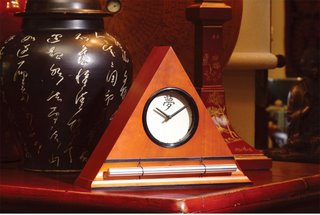 zen clocks and yoga timers with chimes and tibetan bowls Now & Zen
1638 Pearl Street
Boulder, CO 80302
(800) 779-6383
Posted in yoga, Yoga Timer, Yoga Timers by Now & Zen
 Expert yoga pose Are you looking for reasons to start practicing? Here are ways yoga improves your health—reasons enough to roll out the mat and get started.
If you’re a passionate yoga practitioner, you’ve probably noticed the ways yoga works—maybe you’re sleeping better or getting fewer colds or just feeling more relaxed and at ease. But if you’ve ever tried telling a newbie how it works, you might find that explanations like “It increases the flow of prana” or “It brings energy up your spine” fall on deaf or skeptical ears.
As it happens, Western science is starting to provide some concrete clues as to how yoga works to improve health, heal aches and pains, and keep sickness at bay. Once you understand them, you’ll have even more motivation to step onto your mat, and you probably won’t feel so tongue-tied the next time someone wants Western proof.
I myself have experienced yoga’s healing power in a very real way. Weeks before a trip to India in 2002 to investigate yoga therapy, I developed numbness and tingling in my right hand. After first considering scary things like a brain tumor and multiple sclerosis, I figured out that the cause of the symptoms was thoracic outlet syndrome, a nerve blockage in my neck and chest.
Despite the uncomfortable symptoms, I realized how useful my condition could be during my trip. While visiting various yoga therapy centers, I would submit myself for evaluation and treatment by the various experts I’d arranged to observe. I could try their suggestions and see what worked for me. While this wasn’t exactly a controlled scientific experiment, I knew that such hands-on learning could teach me things I might not otherwise understand.
My experiment proved illuminating. At the Vivekananda ashram just outside of Bangalore, S. Nagarathna, M.D., recommended breathing exercises in which I imagined bringing prana (vital energy) into my right upper chest. Other therapy included asana, pranayama, meditation, chanting, lectures on philosophy, and various kriya (internal cleansing practices). At the Krishnamacharya Yoga Mandiram in Chennai and from A.G. Mohan and his wife, Indra, who practice just outside of Chennai, I was told to stop practicing Headstand and Shoulderstand in favor of gentle asana coordinated with the breath. In Pune, S.V. Karandikar, a medical doctor, recommended practices with ropes and belts to put traction on my spine and exercises that taught me to use my shoulder blades to open my upper back.
Thanks to the techniques I learned in India, advice from teachers in the United States, and my own exploration, my chest is more flexible than it was, my posture has improved, and for more than a year, I’ve been free of symptoms.
My experience inspired me to pore over the scientific studies I’d collected in India as well as the West to identify and explain how yoga can both prevent disease and help you recover from it. Here is what I found.
| Flex Time |
| 1 Improved flexibility is one of the first and most obvious benefits of yoga. During your first class, you probably won’t be able to touch your toes, never mind do a backbend. But if you stick with it, you’ll notice a gradual loosening, and eventually, seemingly impossible poses will become possible. You’ll also probably notice that aches and pains start to disappear. That’s no coincidence. Tight hips can strain the knee joint due to improper alignment of the thigh and shinbones. Tight hamstrings can lead to a flattening of the lumbar spine, which can cause back pain. And inflexibility in muscles and connective tissue, such as fascia and ligaments, can cause poor posture. |
Strength Test
2 Strong muscles do more than look good. They also protect us from conditions like arthritis and back pain, and help prevent falls in elderly people. And when you build strength through yoga, you balance it with flexibility. If you just went to the gym and lifted weights, you might build strength at the expense of flexibility.
| Standing Orders |
| 3 Your head is like a bowling ball—big, round, and heavy. When it’s balanced directly over an erect spine, it takes much less work for your neck and back muscles to support it. Move it several inches forward, however, and you start to strain those muscles. Hold up that forward-leaning bowling ball for eight or 12 hours a day and it’s no wonder you’re tired. And fatigue might not be your only problem. Poor posture can cause back, neck, and other muscle and joint problems. As you slump, your body may compensate by flattening the normal inward curves in your neck and lower back. This can cause pain and degenerative arthritis of the spine. |
Joint Account
4 Each time you practice yoga, you take your joints through their full range of motion. This can help prevent degenerative arthritis or mitigate disability by “squeezing and soaking” areas of cartilage that normally aren’t used. Joint cartilage is like a sponge; it receives fresh nutrients only when its fluid is squeezed out and a new supply can be soaked up. Without proper sustenance, neglected areas of cartilage can eventually wear out, exposing the underlying bone like worn-out brake pads.
Spinal Rap
5 Spinal disks—the shock absorbers between the vertebrae that can herniate and compress nerves—crave movement. That’s the only way they get their nutrients. If you’ve got a well-balanced asana practice with plenty of backbends, forward bends, and twists, you’ll help keep your disks supple.
Bone Zone
6 It’s well documented that weight-bearing exercise strengthens bones and helps ward off osteoporosis. Many postures in yoga require that you lift your own weight. And some, like Downward- and Upward-Facing Dog, help strengthen the arm bones, which are particularly vulnerable to osteoporotic fractures. In an unpublished study conducted at California State University, Los Angeles, yoga practice increased bone density in the vertebrae. Yoga’s ability to lower levels of the stress hormone cortisol (see Number 11) may help keep calcium in the bones.
Flow Chart
7 Yoga gets your blood flowing. More specifically, the relaxation exercises you learn in yoga can help your circulation, especially in your hands and feet. Yoga also gets more oxygen to your cells, which function better as a result. Twisting poses are thought to wring out venous blood from internal organs and allow oxygenated blood to flow in once the twist is released. Inverted poses, such as Headstand, Handstand, and Shoulderstand, encourage venous blood from the legs and pelvis to flow back to the heart, where it can be pumped to the lungs to be freshly oxygenated. This can help if you have swelling in your legs from heart or kidney problems. Yoga also boosts levels of hemoglobin and red blood cells, which carry oxygen to the tissues. And it thins the blood by making platelets less sticky and by cutting the level of clot-promoting proteins in the blood. This can lead to a decrease in heart attacks and strokes since blood clots are often the cause of these killers.
Lymph Lesson
8 When you contract and stretch muscles, move organs around, and come in and out of yoga postures, you increase the drainage of lymph (a viscous fluid rich in immune cells). This helps the lymphatic system fight infection, destroy cancerous cells, and dispose of the toxic waste products of cellular functioning.
Heart Start
9 When you regularly get your heart rate into the aerobic range, you lower your risk of heart attack and can relieve depression. While not all yoga is aerobic, if you do it vigorously or take flow or Ashtanga classes, it can boost your heart rate into the aerobic range. But even yoga exercises that don’t get your heart rate up that high can improve cardiovascular conditioning. Studies have found that yoga practice lowers the resting heart rate, increases endurance, and can improve your maximum uptake of oxygen during exercise—all reflections of improved aerobic conditioning. One study found that subjects who were taught only pranayama could do more exercise with less oxygen.
Pressure Drop
10 If you’ve got high blood pressure, you might benefit from yoga. Two studies of people with hypertension, published in the British medical journal The Lancet, compared the effects of Savasana (Corpse Pose) with simply lying on a couch. After three months, Savasana was associated with a 26-point drop in systolic blood pressure (the top number) and a 15-point drop in diastolic blood pressure (the bottom number—and the higher the initial blood pressure, the bigger the drop.
Worry Thwarts
11 Yoga lowers cortisol levels. If that doesn’t sound like much, consider this. Normally, the adrenal glands secrete cortisol in response to an acute crisis, which temporarily boosts immune function. If your cortisol levels stay high even after the crisis, they can compromise the immune system. Temporary boosts of cortisol help with long-term memory, but chronically high levels undermine memory and may lead to permanent changes in the brain. Additionally, excessive cortisol has been linked with major depression, osteoporosis (it extracts calcium and other minerals from bones and interferes with the laying down of new bone), high blood pressure, and insulin resistance. In rats, high cortisol levels lead to what researchers call “food-seeking behavior” (the kind that drives you to eat when you’re upset, angry, or stressed). The body takes those extra calories and distributes them as fat in the abdomen, contributing to weight gain and the risk of diabetes and heart attack.
| Happy Hour |
| 12 Feeling sad? Sit in Lotus. Better yet, rise up into a backbend or soar royally into King Dancer Pose. While it’s not as simple as that, one study found that a consistent yoga practice improved depression and led to a significant increase in serotonin levels and a decrease in the levels of monoamine oxidase (an enzyme that breaks down neurotransmitters) and cortisol. At the University of Wisconsin, Richard Davidson, Ph.D., found that the left prefrontal cortex showed heightened activity in meditators, a finding that has been correlated with greater levels of happiness and better immune function. More dramatic left-sided activation was found in dedicated, long-term practitioners. |
Weighty Matters
13 Move more, eat less—that’s the adage of many a dieter. Yoga can help on both fronts. A regular practice gets you moving and burns calories, and the spiritual and emotional dimensions of your practice may encourage you to address any eating and weight problems on a deeper level. Yoga may also inspire you to become a more conscious eater.
Low Show
14 Yoga lowers blood sugar and LDL (“bad”) cholesterol and boosts HDL (“good”) cholesterol. In people with diabetes, yoga has been found to lower blood sugar in several ways: by lowering cortisol and adrenaline levels, encouraging weight loss, and improving sensitivity to the effects of insulin. Get your blood sugar levels down, and you decrease your risk of diabetic complications such as heart attack, kidney failure, and blindness.
| Brain Waves |
| 15 An important component of yoga is focusing on the present. Studies have found that regular yoga practice improves coordination, reaction time, memory, and even IQ scores. People who practice Transcendental Meditation demonstrate the ability to solve problems and acquire and recall information better—probably because they’re less distracted by their thoughts, which can play over and over like an endless tape loop. |
Nerve Center
16 Yoga encourages you to relax, slow your breath, and focus on the present, shifting the balance from the sympathetic nervous system (or the fight-or-flight response) to the parasympathetic nervous system. The latter is calming and restorative; it lowers breathing and heart rates, decreases blood pressure, and increases blood flow to the intestines and reproductive organs—comprising what Herbert Benson, M.D., calls the relaxation response.
Space Place
17 Regularly practicing yoga increases proprioception (the ability to feel what your body is doing and where it is in space) and improves balance. People with bad posture or dysfunctional movement patterns usually have poor proprioception, which has been linked to knee problems and back pain. Better balance could mean fewer falls. For the elderly, this translates into more independence and delayed admission to a nursing home or never entering one at all. For the rest of us, postures like Tree Pose can make us feel less wobbly on and off the mat.
Control Center
18 Some advanced yogis can control their bodies in extraordinary ways, many of which are mediated by the nervous system. Scientists have monitored yogis who could induce unusual heart rhythms, generate specific brain-wave patterns, and, using a meditation technique, raise the temperature of their hands by 15 degrees Fahrenheit. If they can use yoga to do that, perhaps you could learn to improve blood flow to your pelvis if you’re trying to get pregnant or induce relaxation when you’re having trouble falling asleep.
Loose Limbs
19 Do you ever notice yourself holding the telephone or a steering wheel with a death grip or scrunching your face when staring at a computer screen? These unconscious habits can lead to chronic tension, muscle fatigue, and soreness in the wrists, arms, shoulders, neck, and face, which can increase stress and worsen your mood. As you practice yoga, you begin to notice where you hold tension: It might be in your tongue, your eyes, or the muscles of your face and neck. If you simply tune in, you may be able to release some tension in the tongue and eyes. With bigger muscles like the quadriceps, trapezius, and buttocks, it may take years of practice to learn how to relax them.
Chill Pill
20 Stimulation is good, but too much of it taxes the nervous system. Yoga can provide relief from the hustle and bustle of modern life. Restorative asana, yoga nidra (a form of guided relaxation), Savasana, pranayama, and meditation encourage pratyahara, a turning inward of the senses, which provides downtime for the nervous system. Another by-product of a regular yoga practice, studies suggest, is better sleep—which means you’ll be less tired and stressed and less likely to have accidents.
Immune Boon
21 Asana and pranayama probably improve immune function, but, so far, meditation has the strongest scientific support in this area. It appears to have a beneficial effect on the functioning of the immune system, boosting it when needed (for example, raising antibody levels in response to a vaccine) and lowering it when needed (for instance, mitigating an inappropriately aggressive immune function in an autoimmune disease like psoriasis).
Breathing Room
22 Yogis tend to take fewer breaths of greater volume, which is both calming and more efficient. A 1998 study published in The Lancet taught a yogic technique known as “complete breathing” to people with lung problems due to congestive heart failure. After one month, their average respiratory rate decreased from 13.4 breaths per minute to 7.6. Meanwhile, their exercise capacity increased significantly, as did the oxygen saturation of their blood. In addition, yoga has been shown to improve various measures of lung function, including the maximum volume of the breath and the efficiency of the exhalation. Yoga also promotes breathing through the nose, which filters the air, warms it (cold, dry air is more likely to trigger an asthma attack in people who are sensitive), and humidifies it, removing pollen and dirt and other things you’d rather not take into your lungs.
Poop Scoop
23 Ulcers, irritable bowel syndrome, constipation—all of these can be exacerbated by stress. So if you stress less, you’ll suffer less. Yoga, like any physical exercise, can ease constipation—and theoretically lower the risk of colon cancer—because moving the body facilitates more rapid transport of food and waste products through the bowels. And, although it has not been studied scientifically, yogis suspect that twisting poses may be beneficial in getting waste to move through the system.
Peace of Mind
24 Yoga quells the fluctuations of the mind, according to Patanjali’s Yoga Sutra. In other words, it slows down the mental loops of frustration, regret, anger, fear, and desire that can cause stress. And since stress is implicated in so many health problems—from migraines and insomnia to lupus, MS, eczema, high blood pressure, and heart attacks—if you learn to quiet your mind, you’ll be likely to live longer and healthier.
Divine Sign
25 Many of us suffer from chronic low self-esteem. If you handle this negatively—take drugs, overeat, work too hard, sleep around—you may pay the price in poorer health physically, mentally, and spiritually. If you take a positive approach and practice yoga, you’ll sense, initially in brief glimpses and later in more sustained views, that you’re worthwhile or, as yogic philosophy teaches, that you are a manifestation of the Divine. If you practice regularly with an intention of self-examination and betterment—not just as a substitute for an aerobics class—you can access a different side of yourself. You’ll experience feelings of gratitude, empathy, and forgiveness, as well as a sense that you’re part of something bigger. While better health is not the goal of spirituality, it’s often a by-product, as documented by repeated scientific studies.
Pain Drain
26 Yoga can ease your pain. According to several studies, asana, meditation, or a combination of the two, reduced pain in people with arthritis, back pain, fibromyalgia, carpal tunnel syndrome, and other chronic conditions. When you relieve your pain, your mood improves, you’re more inclined to be active, and you don’t need as much medication.
Heat Treatment
27 Yoga can help you make changes in your life. In fact, that might be its greatest strength. Tapas, the Sanskrit word for “heat,” is the fire, the discipline that fuels yoga practice and that regular practice builds. The tapas you develop can be extended to the rest of your life to overcome inertia and change dysfunctional habits. You may find that without making a particular effort to change things, you start to eat better, exercise more, or finally quit smoking after years of failed attempts.
Guru Gifts
28 Good yoga teachers can do wonders for your health. Exceptional ones do more than guide you through the postures. They can adjust your posture, gauge when you should go deeper in poses or back off, deliver hard truths with compassion, help you relax, and enhance and personalize your practice. A respectful relationship with a teacher goes a long way toward promoting your health.
Drug Free
29 If your medicine cabinet looks like a pharmacy, maybe it’s time to try yoga. Studies of people with asthma, high blood pressure, Type II diabetes (formerly called adult-onset diabetes), and obsessive-compulsive disorder have shown that yoga helped them lower their dosage of medications and sometimes get off them entirely. The benefits of taking fewer drugs? You’ll spend less money, and you’re less likely to suffer side effects and risk dangerous drug interactions.
Hostile Makeover
30 Yoga and meditation build awareness. And the more aware you are, the easier it is to break free of destructive emotions like anger. Studies suggest that chronic anger and hostility are as strongly linked to heart attacks as are smoking, diabetes, and elevated cholesterol. Yoga appears to reduce anger by increasing feelings of compassion and interconnection and by calming the nervous system and the mind. It also increases your ability to step back from the drama of your own life, to remain steady in the face of bad news or unsettling events. You can still react quickly when you need to—and there’s evidence that yoga speeds reaction time—but you can take that split second to choose a more thoughtful approach, reducing suffering for yourself and others.
Good Relations
31 Love may not conquer all, but it certainly can aid in healing. Cultivating the emotional support of friends, family, and community has been demonstrated repeatedly to improve health and healing. A regular yoga practice helps develop friendliness, compassion, and greater equanimity. Along with yogic philosophy’s emphasis on avoiding harm to others, telling the truth, and taking only what you need, this may improve many of your relationships.
Sound System
32 The basics of yoga—asana, pranayama, and meditation—all work to improve your health, but there’s more in the yoga toolbox. Consider chanting. It tends to prolong exhalation, which shifts the balance toward the parasympathetic nervous system. When done in a group, chanting can be a particularly powerful physical and emotional experience. A recent study from Sweden’s Karolinska Institute suggests that humming sounds—like those made while chanting Om—open the sinuses and facilitate drainage.
Vision Quest
33 If you contemplate an image in your mind’s eye, as you do in yoga nidra and other practices, you can effect change in your body. Several studies have found that guided imagery reduced postoperative pain, decreased the frequency of headaches, and improved the quality of life for people with cancer and HIV.
Clean Machine
34 Kriyas, or cleansing practices, are another element of yoga. They include everything from rapid breathing exercises to elaborate internal cleansings of the intestines. Jala neti, which entails a gentle lavage of the nasal passages with salt water, removes pollen and viruses from the nose, keeps mucus from building up, and helps drains the sinuses.
Karma Concept
35 Karma yoga (service to others) is integral to yogic philosophy. And while you may not be inclined to serve others, your health might improve if you do. A study at the University of Michigan found that older people who volunteered a little less than an hour per week were three times as likely to be alive seven years later. Serving others can give meaning to your life, and your problems may not seem so daunting when you see what other people are dealing with.
Healing Hope
36 In much of conventional medicine, most patients are passive recipients of care. In yoga, it’s what you do for yourself that matters. Yoga gives you the tools to help you change, and you might start to feel better the first time you try practicing. You may also notice that the more you commit to practice, the more you benefit. This results in three things: You get involved in your own care, you discover that your involvement gives you the power to effect change, and seeing that you can effect change gives you hope. And hope itself can be healing.
Connective Tissue
37 As you read all the ways yoga improves your health, you probably noticed a lot of overlap. That’s because they’re intensely interwoven. Change your posture and you change the way you breathe. Change your breathing and you change your nervous system. This is one of the great lessons of yoga: Everything is connected—your hipbone to your anklebone, you to your community, your community to the world. This interconnection is vital to understanding yoga. This holistic system simultaneously taps into many mechanisms that have additive and even multiplicative effects. This synergy may be the most important way of all that yoga heals.
Placebo Power
38 Just believing you will get better can make you better. Unfortunately, many conventional scientists believe that if something works by eliciting the placebo effect, it doesn’t count. But most patients just want to get better, so if chanting a mantra—like you might do at the beginning or end of yoga class or throughout a meditation or in the course of your day—facilitates healing, even if it’s just a placebo effect, why not do it?
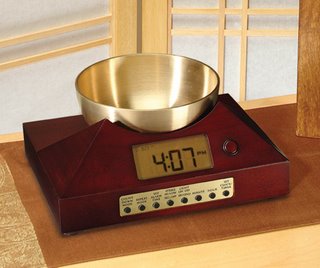 Yoga Timer and Clock with Tibetan Bowl Adapted from Yoga Journal by Timothy McCall, M.D., is Yoga Journal’s medical editor and a board-certified specialist in internal medicine. His book Yoga as Medicine will be released in fall 2005. Check with your health care provider before following any of the recommendations given in this article.
Now & Zen
1638 Pearl Street
Boulder, CO 80302
(800) 779-6383
Posted in yoga, Yoga Timer, Yoga Timers by Now & Zen
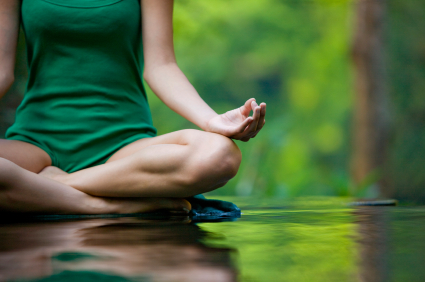 yoga and diet Yoga offers the inner harmony and body awareness required to achieve a healthier approach to eating. All that, and a leaner, stronger body too.
Lanita Varshell is a round, vibrant woman with a zest for life, a joyful smile, a gentle voice, and a passion for teaching yoga to women with weight issues. But Varshell wasn’t always this spirited or committed to yoga. Six years ago, she was incapacitated by fibromyalgia and chronic fatigue syndrome and could barely care for her two young children. Pain and exhaustion forced her to quit her full-time job. At 5 feet 3 1/2 inches and 240 pounds, she was a self-described “couch potato.”
“I’d been obsessed with dieting since I was 10 years old,” Varshell, now 43, says. “I had a history of joining gyms, then quitting. I’d diet, lose 20 or 30 pounds, then gain 40 or 50 back.” Though she’d heard about a gentle yoga class in her area, she procrastinated for six months. When she finally got the courage to attend, the experience touched her on a deep level. “Doing the poses brought tears to my eyes. For the first time in my life, I made a loving connection with my body,” she says. “Before that, my body was always my curse.”
In the years since, Varshell has lost 30 pounds as a direct result of practicing yoga. Increased body awareness has changed her eating habits, and the inner quiet has helped her explore emotional issues she once buried by eating. “Yoga helps you love yourself regardless of extra weight or imperfections,” she states. “I’ve let go of dieting—’die-eating’ to me—and now focus on health. If I keep on the yoga path, weight loss will continue to happen slowly and naturally. Healing weight challenges through yoga is like taking the scenic route instead of the main highway. It’s slower, but much more enjoyable and lasting.”
Although still challenged with fibromyalgia, Varshell’s health and energy have dramatically improved, and she runs her own yoga studio, A Gentle Way Yoga, in San Diego and La Mesa, California, where she teaches very gentle yoga, chair yoga for seniors, traditional hatha yoga, and yoga for super-sized people. Her yoga audiotape, A Gentle Way, disseminates her “gently-does-it” message. Many of her students attribute weight loss to their yoga practice, though Varshell reports that these students don’t obsess about weight as they once did, even if they are still carrying extra pounds. “Now body/mind/spirit health is their—and my—primary focus,” she says. “We’ve become committed to finding out what it means to be healthy—not just thin. Yoga has taught us to appreciate our bodies at any size.”
Varshell’s story inspires me, because I too struggle with my weight. Like her, I think yoga is a wonderful, holistic way to approach the underlying causes of excess fat, which are often a complex mix of physical, emotional, and spiritual issues. Of course, most people associate yoga with skinny, ultra-flexible yogis, not well-padded bodies with Buddha bellies. That’s a shame, because people of girth need yoga as much as—or more than—anyone. For those who, like me, have a tough time with overeating, junk food addiction, unwanted pounds, and the shame that accompanies being less than svelte, yoga offers the peace of mind and body awareness required to achieve a healthier approach to eating. All that, and a leaner, stronger body too.
As my weight has crept higher over the past three years, my self-esteem has sunk lower, leaving me feeling depressed, inferior, and weak-willed. As I increasingly relied on food to bolster me through stressful or unhappy times, I lost confidence in my body, which seemed to betray me. My arches hurt, my back ached, I panted going up steps, I broke my foot. I knew yoga had helped me feel strong and relaxed in the past, but I was too humiliated to do it in such bad shape.
Finally, a few months ago, I started watching gentle yoga videos at home. I remember sobbing on the floor when my barely healed foot couldn’t hold me in Downward-Facing Dog, so I quit. Weeks passed, and a friend invited me to a beginning yoga class. I went, determined not to expect miracles. After one class, something inside me shifted. Next thing I knew, I’d signed up for private sessions with the yoga teacher to work on modifying poses. At the same time, I started making dietary changes. After a month of doing yoga three or four times a week, my flexibility was returning, and I was ecstatic the day I held Tree Pose while balanced on my weak foot.
I’d been so excited about my new strength—which improves weekly—that I paid little attention to the scale, although I dropped a trouser size in a month. Part of my 15-pound weight loss resulted from all those fruits and veggies, but the experience taught me that yoga and other weight-loss measures are perfect partners. Making any lifestyle change is achingly slow, so what better way to practice patience than through yoga?
Keep in mind that achieving and maintaining a healthy body weight has benefits other than appearance, since excess body fat puts you at serious risk for a number of health problems. If your body fat percentage is greater than 30 percent for women or 25 percent for men, your risk of developing diabetes, heart disease, high blood pressure, and colon or breast cancer increases. So in addition to helping you feel better about yourself—which is crucial for those working to lose weight—yoga can inspire your commitment to better health. Besides putting me in touch with my body, yoga has made physical activity easier and more enjoyable. I’m motivated to add more cardiovascular exercise into my routine, thereby accelerating my weight loss and helping me reduce the likelihood of developing more health problems.
Emotional Evolution
There are many reasons why people feel powerless over food and gain weight. I use food as emotional comfort or to calm my anxiety. Sometimes eating seems the easiest way to feed unfulfilled inner hunger. Often, people rely on fast food to speed them through their too-fast lives. Many simply ignore their bodies’ needs for nutrition and exercise. Regardless of the cause, yoga is an antidote for food oblivion—it slows us down so we experience the body and commune with the spirit.
If there are emotionally based reasons why a person eats unwisely, it may be that yoga—especially the relaxation—opens a channel for clearing those emotions. Varshell relates a student’s discovery after shedding 20 pounds: “This woman realized through yoga how many emotions she stored in her body. She usually stuffed those feelings with food,” she explains. “I’m convinced if you don’t allow yourself to release emotions, they’ll come out as rage, disease, depression, or excess weight.”
Brian Vandoske, 36, of Sheboygan, Wisconsin, who has lost 40 pounds since he committed himself to yoga five years ago, believes he keeps it off because yoga nourishes his spirit. “The soul is a major piece of the puzzle for people struggling with weight,” he says. “Those of us with extra pounds can go to Weight Watchers and deal with the nutrition issue, but we haven’t dealt with the soul.
“Anybody who takes on yoga winds up facing the inner issues as to why they’re overweight,” Vandoske continues. “Since my father passed away when I was 6, I’ve used food as a security blanket.” Working with a yoga therapist gave him tools to cope with that loss and his mother’s death five years ago. “Now if I feel depressed, I go to the cushion and meditate. I’ve also developed a network of people to talk to,” he adds. Every week he drives 50 miles to Milwaukee to a class taught by a yoga instructor who supports his efforts. “The diet industry has set up millions of Americans to fail,” Vandoske says. “Fortunately you can never fail in yoga, which emphasizes accepting your body as it is.”
Body awareness, an integral part of yoga, is crucial to weight loss. When I feel low, I crave an “out-of-body experience,” which I achieve by numbing myself with M&Ms. But when I’m in touch with myself through yoga, it’s easier to stay in the present, and I feel less need to escape. That’s why Genia Pauli Haddon, the ample-bodied cocreator of the Yoga for Round Bodies videos, calls yoga “coming home to yourself.”
“I never imagined myself doing yoga,” confesses the instructor from Scotland, Connecticut. “I believed yoga was for skinny, human-pretzel types.” However, Haddon’s friend, Linda DeMarco, convinced her to try it. Soon they developed instructions for many postures to allow for the reality of a big belly, heavy thighs, and large breasts. And, without trying, they both lost weight. “Years ago, I gave up on diets and pills and accepted that I would always be heavy, so it was a surprise to find that because I loved doing yoga, I was losing weight,” says Haddon.
“I think the pounds came off because I was in harmony with myself,” she continues. “Through yoga I experienced simply being. Then, anything not in harmony naturally fell by the wayside. The change occurred not just in how much I weigh, but in my attitudes. I learned to be more patient by staying with a yoga posture. And I have a greater capacity to be with myself emotionally, even through painful times. As I learned to stay present through yoga, I used food less as a substitute way of feeling better. However, I didn’t become a ‘skinny-mini.’ I’m still a short, round woman. And I like my body, largely as a result of my experience on the yoga mat.”
Varshell echoes those sentiments. “Whether or not I ever wear size six or eight is no longer important to me,” she says. “Long ago, I hated myself when I weighed 150, so I kept eating until I hit 180. I still hated myself at 180, so I progressed to 240. I knew I was headed to 300 pounds if I didn’t change my perception that weight determined how successful or loved I was. I was waiting to live life until I was the right size. Now getting my body, mind, and spirit in harmony is a spiritual journey.”
Even soul journeys, however, can be bumpy. It can take a lot of courage for a substantial-sized person to try yoga. “Years ago, I bought a ‘beginning’ yoga video in which this toothpick of a woman demonstrated the Wheel,” says Sherry Kreis, a size 20 woman from Denver. “I took one look at her bending over backwards with her little hip bones sticking out, and thought, ‘My body will never do that.’ I was so intimidated that I never even watched the rest of the tape.”
However, a year ago, Kreis started yoga at the urging of her friend Kate Chapman Sharpe, another woman trying to lose 30 pounds, and the two have stuck with it together. “It took guts to walk into that first class,” Sharpe says. “Because the teacher had a soft voice I couldn’t hear from the back of the gym, I realized I was going to have to stand in front and let go of my inhibitions about somebody looking at my butt. So, I told myself, ‘It doesn’t matter what I look like. What matters is I’m trying.’ ”
Over the months, as Sharpe and Kreis toned their bodies, they’ve realized there are yoga benefits beyond how you look in your jeans. “Last year my husband suffered a stroke and heart attack,” says Sharpe. “Without yogic breathing, I couldn’t have remained level-headed.” She’s reaped other rewards as well. “When I began yoga, my teacher said smoking wouldn’t interfere with my yoga, but yoga would interfere with my smoking. I’m finally at the point where I’m willing to quit,” she vows. “I think yoga might eventually interfere with my love of chocolate and rich food in much the same way.”
Relationships with Food
When you practice yoga, you develop a deeper relationship with your body, which eventually translates into more controlled eating. After a yoga class, you feel better, because your soul is happy, your energy is moving, your mind is clear, and you’re tuned in to yourself, says Suzanne Deason, a Marin County, California, teacher who developed the video Yoga Conditioning for Weight Loss. “In this relaxed state, you’re more likely to fix something nourishing rather than grab the first food you crave,” she notes. Deason remembers one woman who attended class five times a week, eventually losing 35 pounds. “She told me that yoga helped her body feel so much better that she stopped eating foods that weren’t good for her,” she says.
And yoga works where diets often fail. “Yoga—unlike dieting—is not about depriving yourself to look a certain way,” Varshell observes. “Instead, it helps you enjoy every movement and savor every bite of food you take. Yoga is about going deep inside and discovering who you are right now. Yoga helps you accept yourself at any size, looking lovingly and realistically at how you got where you are today, without blame or shame.”
However, shunning diets doesn’t excuse a person from eating well, Varshell points out. “We all must take responsibility for our food choices,” she says. “To feel good, you need to implement balanced, healthy eating habits.” She distinguishes between being on a diet—a regimented program—with choosing good food. “A friend who’s dropped 20 pounds says yoga has helped her with ‘loving discipline,’ ” she explains. “We usually think of discipline, especially diets, as punishment. But the word ‘discipline’ is actually from the word disciple. In yoga we become disciples, people willingly, excitedly following a new way of doing something to enhance our way of life. By regularly practicing yoga, your habits and choices improve, and you begin living consciously.”
Yoga for All Shapes
Besides nurturing self-acceptance, yoga offers physiological benefits. “Yoga may not bring you to the point of burning off that last 10 pounds,” admits Deason, “but you do experience muscle toning. Standing poses in particular tone and trim your legs, hips, buttocks, and abdomen, while developing stability and strong muscles. Building the large muscle groups increases the muscle-to-fat ratio, which speeds weight loss since muscle burns calories quickly.”
In addition, yoga increases energy and circulation, which contribute to overall well-being. “Yogic breathing oxygenates your body, helping your metabolism function at a higher level,” Deason says. Vinyasa, with its fast-paced, continuous motion, raises the heart rate, though not to the extent of cardiovascular exercise. However, Deason warns that focusing solely on burning calories misses the point of yoga.
The cardinal rule in yoga is to honor your own ability, no matter what your weight is. Driving yourself too hard is an invitation to injury and discouragement. “Stay true to who you are, just tickling your personal edge—the place in a pose between what you can do easily and where it becomes more difficult than is safe,” says Haddon. “In yoga, you receive the full benefit by respecting your own level of comfort, ability, strength, and flexibility. You undercut the process if you start comparing yourself to somebody else.”
Gentle yoga is essential for someone of substantial size. “I teach people to work slowly and softly, so they succeed, rather than becoming more frustrated than before they started,” says Naomi Judith Offner, whose video Gentle Yoga with Naomi is a good guide for those of us with round bodies. “It’s when people fail at exercise—when they don’t feel comfortable in a class—that they go out and eat from frustration, stress, and anxiety.”
If you have difficulty bending, kneeling, or lying on the floor, start with very gentle yoga that can be done in a chair or in bed. Light stretches and attention to the breath leave you feeling deeply relaxed but invigorated. Once you’re comfortable with gentle movement, you can try other levels, using modifications and props. For instance, a series of asanas—including the classic Sun Salutation—can be done in a chair or with a chair for support, says Nischala Joy Devi, author of The Healing Path of Yoga (Harmony, 2000). “My goal is to help people benefit from yoga without injury or strained muscles,” says Devi. She also notes that size is not a measure of flexibility. “Many people with a few extra pounds are incredibly flexible,” she says. “Conversely, many thin people are quite stiff.”
Modify the Poses
No matter how well-meaning a thin yoga teacher is, she or he has probably never experienced yoga as a person of girth. That’s why it’s important for you to know your abilities and keep your practice safe—but just challenging enough—for you.
Common concerns for us heavy people include reaching arms above our heads, folding into a forward bend (and being able to breathe once we’re there!), sitting cross-legged, holding a pose for a length of time, and experiencing back and knee strain due to added weight around the middle. But in yoga there are always solutions. Place a bolster under the knees to alleviate back strain when lying down; when seated cross-legged on the floor, fold a blanket under your rear. If you can’t reach your arms around your knees to pull them to your chest when lying down, a belt will extend your reach.
“You don’t have to sacrifice a posture if your body doesn’t bend like a pretzel,” Haddon says. “But be sure to honor both the posture and your own body.” Her advice is to err on the side of caution. For instance, if your weight stresses your lower back, proceed slowly, with awareness. “If you gently and gradually work into postures such as Cobra and Boat, you can strengthen your back,” Haddon says.
Balancing poses require special attention. “People of substance run a greater risk of spinal injury in inverted balancing poses and should avoid them,” Haddon says. When a heavy person does Headstand, she or he needs considerably more muscle power to correct a slight wobble than a lean person needs to correct the same degree of imbalance, she explains. (Tree Pose, on the other hand, develops balance and is safe for full-sized bodies.) And take credit for your own strength. “It amuses me to think the weight I’m hoisting in Plank is equivalent to what those buff guys in the gym are bench-pressing,” says Sharpe.
Props can help you fully benefit from yoga, compensating for tight joints, limited flexibility, or arms that don’t reach around an expansive body. Vandoske considers himself the king of yoga props—he routinely packs a pair of blocks, two straps, two sandbags, a blanket, and a mat when he heads off to the studio. “Props get me to a level in a pose where I feel comfortable and can improve,” he says. “The key to success in yoga for anybody carrying extra weight is to modify. Accept where you are and don’t be afraid to experiment with modifications.”
Often, a pillow beneath the forehead can make it easier to settle into Child’s Pose, or a strap can help open the hips and hamstrings. Don’t worry whether modifications are kosher. “Yoga is about being comfortable,” says Devi. “The definition of asana in the Yoga Sutra is ‘a comfortable and steady pose.’ But the word used for ‘comfort’ is sukha, which also means ‘happiness.’ If what you do brings happiness, then you’re doing real yoga,” she adds.
“Yoga involves so much stretching,” says Sharpe. “There are downward stretches, side stretches, intellectual stretches, and emotional stretches.” Indeed, both processes—learning yoga and losing weight—require patience and perseverance. A yoga practice takes time to cultivate; likewise, unwanted pounds won’t disappear overnight.
Because it fuses spiritual with physical practice, yoga offers a path for self-discovery and self-acceptance. Through it, I’m more attuned to my needs and feel better physically and emotionally.
No, yoga won’t always keep me from noshing on nachos.
Yet I respect myself more than before I started yoga, and I’m more likely to acknowledge my successes: small ones like holding Downward-Facing Dog for four breaths instead of two, big ones like taking a meditation break instead of a cookie break.
In time, yoga can transform you and your body. With work and years of yogic practice, Varshell has overcome illness, improved her relationship to eating, polished her self-image, and shed pounds. “Now I see food as a way to love and nourish my body, rather than hide from my emotions,” she says. “Holding a pose long enough to feel muscle after muscle let go and melt into the floor touches me in a way that ice cream never could.”
adapted from Yoga Journal by Boulder, Colorado-based freelance writer Laurel Kallenbach wrote the feature on pilgrimage for our September/October 99 issue.
 Bamboo Chime Alarm Clock and Timer for Yoga Now & Zen
1638 Pearl Street
Boulder, CO 80302
(800) 779-6383
Posted in yoga, Yoga Timer, Yoga Timers by Now & Zen
« Previous Page — « Previous Entries
Next Entries » — Next Page »
|
|
|
|